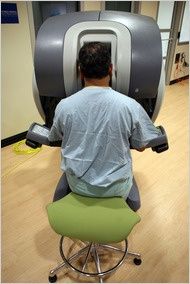Robotic surgery is a type of minimally invasive surgical procedure that uses a robotic system to control surgical instruments. The robotic system is controlled by a surgeon who operates from a console using hand and foot controls. In recent years, robotic surgery has become increasingly popular, despite concerns over its effectiveness and cost. In this essay, we will discuss the rise of robotic surgery, its pros and cons, and the debate over its effectiveness.
Background
Robotic surgery has been around for over two decades. In 1999, the da Vinci Surgical System, the first robotic surgical system, was approved by the US Food and Drug Administration (FDA). Since then, the number of robotic surgeries performed each year has increased significantly. In 2018, over 1 million robotic surgeries were performed worldwide.
Advantages of Robotic Surgery
One of the main advantages of robotic surgery is its minimally invasive nature. Unlike traditional open surgery, which requires large incisions, robotic surgery only requires small incisions. This results in less pain, scarring, and blood loss. Additionally, the smaller incisions often result in a shorter recovery time and a shorter hospital stay. This can lead to a lower risk of infection and other complications.
Another advantage of robotic surgery is its precision. The robotic system is designed to provide greater control and dexterity than traditional surgical instruments. This can be especially beneficial for delicate procedures such as prostate surgery, where the robot's precision can help preserve the nerves that control urinary and sexual function.
Finally, robotic surgery can help reduce surgeon fatigue. Traditional open surgery requires the surgeon to stand for long periods of time, which can lead to fatigue and discomfort. Robotic surgery allows the surgeon to operate from a console, which can be more comfortable and reduce fatigue.
Disadvantages of Robotic Surgery
One of the main disadvantages of robotic surgery is the cost. The da Vinci Surgical System, the most commonly used robotic surgical system, can cost up to $2 million, with an additional $170,000 in annual maintenance fees. Additionally, each procedure can cost up to $3,000 more than a traditional open procedure. This increased cost can be a barrier to access for many patients, especially those without insurance or with limited financial resources.
Another disadvantage of robotic surgery is the learning curve. The robotic system requires specialized training and experience, and it can take time for surgeons to become proficient in its use. This can result in longer operating times and a higher risk of complications for patients.
Finally, there are concerns over the effectiveness of robotic surgery. Some studies have shown that robotic surgery does not offer significant benefits over traditional open surgery in terms of outcomes such as mortality and complication rates. Additionally, some critics have argued that the precision of the robot may not be necessary for many procedures, and that the increased cost of robotic surgery may not be justified.
The Debate over Effectiveness
Despite the concerns over its effectiveness and cost, robotic surgery has won over many converts in recent years. Proponents of robotic surgery argue that its precision and minimally invasive nature can lead to better outcomes and a higher quality of life for patients. Additionally, proponents argue that the cost of robotic surgery can be justified if it leads to fewer complications and a quicker recovery time.
Critics, on the other hand, argue that the benefits of robotic surgery are unproven, and that the increased cost may not be justified. Some studies have shown that the outcomes of robotic surgery are not significantly better than traditional open surgery, and that the precision of the robot may not be necessary for many procedures. Additionally, some critics argue that the increased cost of robotic surgery may not be justified, especially given the high cost of healthcare in the United States.
While robotic surgery has its advantages, such as increased precision and less pain and scarring, it also has its disadvantages, including the high cost and the learning curve required to become proficient in its use. Additionally, there is debate over the effectiveness of robotic surgery, with some studies showing that it does not offer significant benefits over traditional open surgery.
Despite the debate over its effectiveness, the popularity of robotic surgery continues to rise. This may be due in part to the marketing efforts of the manufacturers of robotic surgical systems. Additionally, some patients may prefer robotic surgery because of its minimally invasive nature and the perception that it is more advanced than traditional open surgery.
Ultimately, the decision to undergo robotic surgery should be made on a case-by-case basis, taking into account the patient's medical history, the complexity of the procedure, and the risks and benefits of each surgical approach. It is important for patients to discuss their options with their healthcare provider and to be aware of the potential risks and benefits of robotic surgery.
In conclusion, while robotic surgery has its advantages, it also has its disadvantages and concerns over its effectiveness. As with any medical procedure, the decision to undergo robotic surgery should be made based on individual circumstances and after careful consideration of the risks and benefits.
